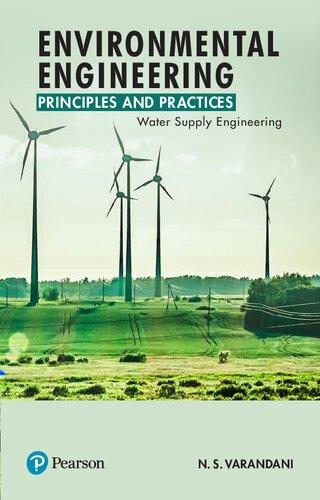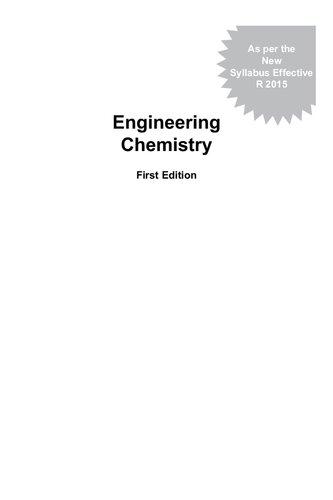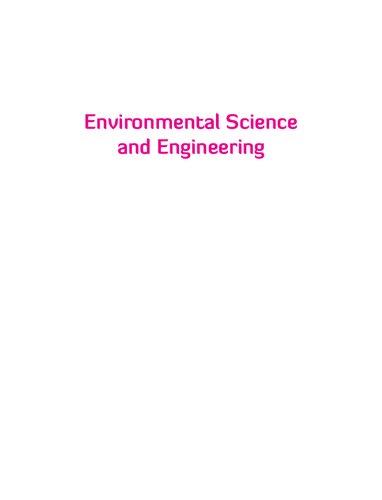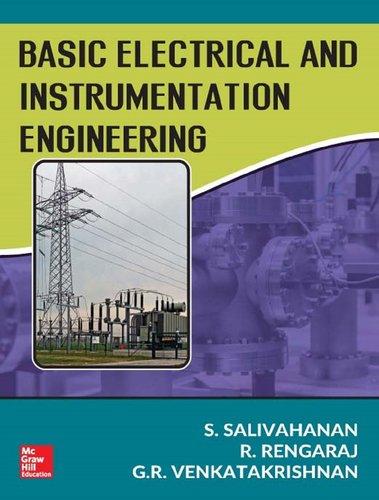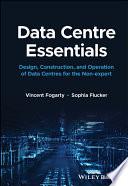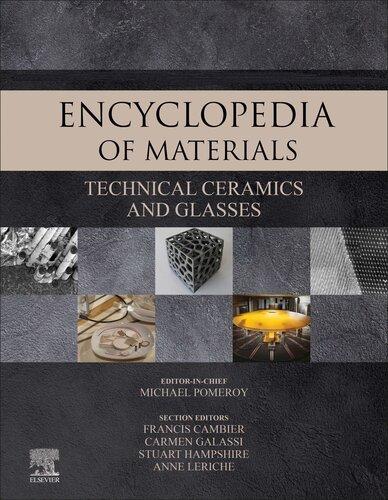P refa C e
This book, Environmental Engineering: Principles and Practices – Volume-I is the consolidation of the information gathered and the understanding developed during my long academic career of 30 years. The book is intended to be useful for students of civil engineering pursuing the course in environmental engineering at the undergraduate level. It will be useful to the students pursuing environmental engineering, at different levels during their journey to becoming qualified environmental engineers.
Practising engineers, academicians and post graduate students may also find the book useful as a reference text book, particularly, the chapters on industrial wastewaters, air pollution, noise control and the complete design of water treatment plant.
Sincere efforts have been made to address the multi disciplinary nature of environmental engineering and to consolidate the scattered information in a manner that makes reading attractive and easy to understand.
Volume I has been designed and organised to incorporate varied topics, some of which are usually, not covered in books on environmental engineering—e.g. environmental microbiology, house drainage, environmental impact assessment, environmental audit and the complete design of water treatment plant.
The contents of the book have been divided into 14 chapters. Each chapter is devoted to a particular aspect of the environmental engineering such as: environment and its components (chapter 1); environmental microbiology (chapter 2); quantity of water - availability and demand (chapter 3); water quality (chapter 4); wastewater characteristics (chapter 5); industrial wastes: origin, characteristics and treatment (chapter 6); air pollution: sources and effects (chapter 7); air pollution: pollutant control system (chapter 8); solid waste management: generation, collection and transportation (chapter 9); solid waste management: processing, treatment and landfilling (chapter 10); noise: sources and control (chapter 11); house drainage (chapter 12); environmental impact assessment and audit (chapter 13) and water treatment (chapter 14).
Chapter 1, on environment and its components, presents the basic information about the environment and the important components, with focus on the interaction.
Chapter 2, on environmental microbiology, deals with microbiology as applied by environmental engineers in the field, while not losing in the basic aspects of microbiology.
Chapters 3 and 4 are devoted to the quantity and quality of water, covering the sources of water, water demand and the quality aspects. Sources and effects of the impurities in water are also presented.
Chapters 5 and 6 cover various aspects of wastewater sources, characteristics and treatment with a particular focus on the industrial wastewaters. Determination and importance of wastewater characteristics of concern have been covered. A full section has been devoted to Biochemical Oxygen Demand (BOD), Chemical Oxygen Demand (COD), Total Organic Carbon (TOC) and Theoretical Oxygen Demand (ThOD). Considering the limitations of the book, a few industries with high pollution potential have been covered at length. I am sure, practising engineers as well as students and professors will find the information useful.
Chapters 7 and 8 are devoted to air pollution—sources, effects and control of pollutants. A brief description of particulate matter and gaseous pollutants control equipment(s) has been presented to expose the reader to basic principles and practices.
Chapters 9 and 10 present the aspects of solid waste management starting from the source(s) to landfilling. The topics such as solid waste generation, collection, transportation, processing, treatment and landfilling have been covered with a conscious focus on the Indian scenario, which represents any other developing nation.
Noise, with an all round development and increasing awareness is becoming an important irritant. Considering this fact, chapter 11 focuses on the sources, effects and control of noise.
Chapter 12 on House drainage, adds a uniqueness to the book and has been incorporated with specific intention to expose the reader to the fact that the quick and efficient discharge of wastewater from buildings—residential and commercial, is as important as its collection, transportation and treatment. Civil engineers, in particular, will find the information useful.
Chapter 13 covers the environmental impact assessment (EIA) and audit - the most important environmental management tools—one deals with the pre-project activities and the other, with post project. While EIA has been briefly covered to provide the basic information, environmental audit has been covered extensively. The successful implementation of environmental audit scheme in Gujarat (India), has also been presented.
Finally, chapter 14 is devoted to water treatment systems. While it provides an insight into the different unit operations and processes involved in the treatment of water, it also includes the design of water treatment plant for 20 MLD. The design criteria and the relevant equations for treatment units have been presented in a ready to use format.
Each chapter provides a comprehensive list of the review questions to help students and faculty to better understand the contents of the book and relate the same to the specific question.
Although sincere efforts have been made to cover as much as possible, but as with any book, quite often, the specific purpose of the book prevails, while some topics not being covered fully. The readers may find the same with this volume. A conscious effort has been made NOT to cover the theory and design of wastewater treatment units which are planned to be covered in Volume II of the book.
Developing the contents and accomplishing the task of writing a book is a time consuming and cumbersome (but exciting) process which results in some errors slipping through. I will be personally obliged if the reader brings such errors or omissions to either the author’s or publisher’s notice. Any suggestion(s) to improve the content and quality of the book are welcome.
This book comprehensively covers the syllabus prescribed by a number of universities across the country for the courses offered to civil and environmental engineering students.
A cknowledgements
This book is the result of my being a staunch believer in ‘God has better plans for me’. First of all, I would like to express my gratitude and indebtness to God, the Almighty who has not only inspired me, by blessing me through my mother, Shanta, but also graced me with good health during the development of this book.
Publishing a book cannot be a solo effort. Many people have directly or indirectly, contributed in the completion of this book. I thank all of them.
I sincerely acknowledge and appreciate the efforts and hard work of Ms Monika Panchani, my student and co-worker. Without her unconditional support, it would have been a difficult task for me.
I also appreciate Mr Bhavesh Jadav, Proprietor, Soft Touch Graphics, Ahmedabad for his long work hours and his cheer in making corrections as demanded during the initial typing process of the manuscript.
I dedicate this book to the members of the VARANDANI family. I wish to especially thank my wife, Mohini Varandani, for her constant support and patience during the writing of this book.
Finally, I would like to thank R. Dheepika and C. Purushothaman of Pearson India Education Services Pvt. Ltd. for pushing the book to publication.
Prof. Dr N. S. Varandani
a B out the a uthor
Prof. Dr N. S. Varandani has a long academic career spanning over 30 years. He has been teaching different subjects of Environmental Engineering at the Department of Environmental Engineering, L. D. College of Engineering, since 1988. At present, he is offering his services as a Principal Research Scientist at the Gujarat Energy Research and Management Institute, Gandhinagar, since 2013. He earned his Ph.D. in Renewable Energy from Sardar Patel University in 2004. His teaching and research contributions primarily aim to enhance the adoptability of “Waste-to-Energy” approach using anaerobic treatment systems for organic wastes, in particular and thermal gasification for solid municipal waste.
He has guided more than 100 theses of master degree, published technical papers in national journals and delivered expert lectures on different environmental issues.
He is the recipient of Dr Vikram Sarabhai Award for Science and Technology, 2009 for developing “Integrated Air Pollution Control System for Foundry Industry”
He is a member of several government and non-government organisations contributing towards environment protection and management.
C ompon E nts
1.1 INTRODUCTION: BACKGROUND AND DEFINITIONS
Up till 1960, the terms ecology and environment drew little attention of politicians and social scientists. However, with the publication of a landmark book titled Silent Spring written by Rachel Carson coupled with the occurrence of major oil spill accidents along the southern coasts of California and Massachusetts causing environmental disruptions Environment became a popular issue and attracted the attention of politicians as well as the general public. However, as with any new political or social issue. Initially it was supported by minority of people.
With the passage of time, as the understanding of the importance of protecting the surroundings improved the concept of environment evolved to be more inclusive with more focus on the complex interactions between the man’s activities and all the components of natural environment. As on today, the environment has become an important issue, both political as well as social, throughout the world.
In fact, definition and relevance of the term environment changes with the context perception and the conditions (under which it is used) and hence different people define environment differently as given in subsequent sections.
1.1.1 Definitions
Environment is derived from the French word environner which means to encircle or surround. It is believed to have been introduced by biologist Jacob van Erkul in the early 1900s.
Not a single organism on this earth is alone. We all are always surrounded by a lot of things such as other organisms, plants, water, air, light etc. Such surroundings—all the living and non living things-constitute the environment.
There are many different definitions of the word environment, in literal and scientific contexts, but the most acceptable definitions can be as given here under:
(i) Environment can be defined as the natural surroundings of an organism which, directly or indirectly, influences the growth and development of that organism.
(ii) Environment is the sum total of all living and non living elements that compose the surroundings of any living entity.
(iii) Environment is the sum of all surrounding external conditions affecting the life and the development of organisms, people, animals or plants etc.
Understanding Environment requires answers to following three questions:
(i) What is surrounded?
(ii) What surrounds? and
(iii) Where surrounded?
Let us try to answer these questions:
(i) What is surrounded?
Living entities in general and man in particular.
(ii) What surrounds?
Surrounded by living and non-living attributes (inseparable characteristics) such as air, water, land, plants, animals, organisms, etc. Man cannot exist in isolation of other forms of life. With the passage of time, the surrounding external conditions affecting the man’s life now also includes social, economic and political functions.
(iii) Where surrounded?
In the Biosphere.
The biosphere refers to the space occupied by life that is affected by the physical components of the planet earth such as water, land, air and sunlight.
1.1.1.1 Comprehensive Definition of Environment
Summing up all the above expressions, environment can be defined as:
The term environment means all the external surroundings of a living creature which include biotic and abiotic components affecting its life and growth.
The biotic (living) component includes plants, animal predators, other living species with synergistic or otherwise relationship, bacteria, virus, food etc.
A biotic (non living) component typically includes land, water, air and sunlight.
Simply defined the term environment refers to the sum total of biotic and abiotic components of the surroundings.
1.2 ThE hUmAN ENvIRONmENT
The definition of environment takes a different dimension while describing environment with reference to human, as the growth and development of human is strongly influenced by social and economic factors also. Hence ‘human environment’ comprises of biotic, abiotic and socio-economic aspects. i.e., bio-geo-physical and socio-economic aspects. Infact, human environment has two components, namely;
(i) Natural environment; and
(ii) Man-made environment.
(i) The natural environment comprises of 4 spheres: (a) The Biosphere: space occupied by life.
(b) The Atmosphere: space occupied by air.
(c) The Lithosphere: space occupied by land.
(d) The Hydrosphere: space occupied by water.
The four spheres, exist and interact with each other as shown in Fig. 1.1. All the four spheres combined make an ecosphere.
Figure 1.1 The four spheres
(ii) The man-made environment comprises of
(a) Anthropogenic (human related) ecosystems—interactions among and between humans (socio-economic), other living beings (biotic) and non-living (abiotic) things; and
(b) Physical structures:
One way to represent the definition of human environment is shown in Fig. 1.2.
Total environment
Behavioural, social, natural and physical environment
Social, natural and physical environment
Natural and physical environment
Physical environment
1.2 One way to represent human environment
Figure
As shown, the total environment comprises of bio-geo-chemical-physical-socio-economic and cultural elements or factors affecting the human life. This is the most inclusive definition. It needs to be understood that inclusion or exclusion of any element or factor will change the definition from the most inclusive (total environment) to most restrictive (physical environment) as shown in Fig. 1.2.
In this text, the term environment refers to human environment unless stated otherwise.
1.2.1 man, Environment and Religion
The two words Man and Environment are not new to the human history and the inter relationship between them is well established. Thinking about the environment is as old as our first human ancestors. Their survival depended on knowledge of it. The concern for the environment is also not new. Since ancient times, people have known the importance of preserving it. Worshipping of trees and rivers, animals and birds was not based on superstition; but there was a hidden message of preserving and protecting the environment. The religious rituals served an important purpose—they made people aware of the environment and its importance and so indirectly helped preserve and nurture it. Religion was used largely to ensure community participation in all those practices that would lead to the maintenance of ecological balance.
1.2.2 man and Environment: The Interactions
There are two types of interactions:
(i) Interaction between Man and Environment; and (ii) Interaction between other organisms and Environment.
What we make of our life depends upon what we do with and how we interact with the environment.
In the 20th century, it became apparent that mankind is having an increasing effect on the planet’s ecosystems and bio-geo-chemical cycles. Infact, our activities are now causing environmental changes which are over riding the natural dynamism of the Earth. There is a concrete evidence of environmental problems such as bio diversity loss, land cover change, climate change ozone hole, acid rain, water scarcity, air pollution episodes etc and many examples of effects of environmental pollution. But we still continue with the activities that perpetuate (occurring continually) the problems. As the world’s population increases and the per capita consumption of natural resources increases, we will have an even greater effect on these environmental problems.
Recognising environment–related problems as ours and not theirs is the first step towards strengthening the man-nature environment-bonding.
It is ironical that inspite of ever increasing public awareness, media attention, directional research, national and international legislations, trans—boundary agreements with advancement on the industrial development first and improving living standards of people, newer environmental issues and problems are being added to already a long list of unresolved ones.
1.2.3 The Anthropocene
Humans have gained an enormous capacity to alter Earth and its support systems. Their influence is so great that we are now entering a new epoch (era) the anthropocene in
which human activities have effects that largely determine conditions on the planet. The major effects of human activities on Earth, as a whole, have taken place within a small period of time (during 20th centuary) relative to the human history.
1.2.3.1 Population: As the Root Cause of Pollution
Human population was about 5 million (1 million = 10 lacs) in the year 6000 BC. By 1650 AD, It was 500 millions. By 1850 AD it had reached one (1×109) billion and is estimated to reach 9 billions (9×109) by 2040. Such a rapid increase in human population is rapidly causing what is known as Environmental Degradation. In fact, all the present day environmental problems can be related to increasing population, improving living conditions, enhanced consumptions (of resources) and technological developments. In fact, human population can be regarded as the primary cause of pollution or as the root cause of pollution as everything else resolves around it.
To illustrate this and establish relation between environmental degradation population, let us consider the following points:
(i) Rapid industrialization
(ii) Pressure on natural resources
(iii) Growing more food
(iv) Urbanization
(v) Increase in number of vehicles
(vi) Deforestation and desertification
(i) Rapid Industrialization:
To feed and provide employment to the ever increasing numbers and to improve the living standards of people, humans have adopted the path of industrialization. As a result, the last centuary witnessed the rapid industrialized growth and economic development world over.
This rapid industrialization, not only consumes (eater use up) natural resources rapidly, possibly leading to exhaustion of some key (important) energy resources like oil, but also produce wastes in the form of liquid discharges polluting water bodies, gaseous emissions polluting atmosphere and solid (hazardous) wastes affecting land resources, which ultimately pollute the environment.
India has also adopted the path of Industrialization to satisfy the needs and greeds of its rapidly increasing population with the result of huge back log (accumulation) of population.
This explanation can be best understood by referring to Figure 1.3.
(ii) Pressure on natural resources:
The rapid increase in human population has produced a number of adverse effects on the natural resources of the biosphere. The pressure on two important natural resources, namely forest and water is discussed here.
(a) Forests:
While there is no single cause for deforestation a growing population increases a variety of activities that can degrade or destroy forest. Particularly the activities like collection of fire wood, commercial harvesting and agriculture expansion result in removal of forests. As a result per capita forest area worldwide has decreased by more than 50% since 1960.
Resources
Quality of life
Economic output
Industrial activities
Environment
Supportive carrying capacity Assimilative carrying capacity
Environment’s carrying capacity
Figure 1.3 Economic development & environmental pollution
(b) Water:
Due to increasing population, water is not only being polluted but, in fact, the demand also increases.
With rapidly growing population and improving living standards the pressure on our (India’s) water resources is increasing and per capita availability of water resources is reducing day by day. For example in India per capita surface water availability in 1991 and 2001 were 2309 m 3 and 1902 m 3 respectively and these are projected to reduce to 1401 m 3 and 1991 m 3 by years 2025 and 2050 respectively, mainly to increase in population.
The pressure on energy resources, particularly on fossil fuels such as coal, gas and oil has also increased to such an extent that some of them are facing exhaustion.
(iii) Growing more food:
With the increasing population the number of mouths to be fed also increase. According to UN estimates, at least 800 million people are hungry in the world today. Will it be possible to feed everyone living on the earth adequately when population becomes 9×109 by 2040? To sustain a population of 9×109 – 10×109 by 2050 at current nutritional levels, the production will have to be increased by 3 times almost from today’s farm land. However, as per the basic assumption of Malthusian theory of maximum population (Fig 1.4) the food production growing at slow arithmetic rate will never be matching with the human population increasing at rapid geometric rate. For India, the predicted scenario is bad as by 2050 the population reaching 1.6×109 will have food demand of 500×106 tons as against present production of 215×106 tons per annum.
To continuously increase the food production, there are two alternatives namely:
(a) Expand the crop land
(b) Increase the crop yield
Expanding the crop land seems practically impossible option.
The food grain production can be increased by using fertilizers and pesticides along with optimum use of water. The use of synthetic fertilizers and pesticides from the farm land cause the water pollution and results in to several ecological problems like algal blooms and health problems.
(iv) Urbanization:
Urbanization is primarily due to the natural increase in population (due to difference in birth and death rate) and migration of rural people to towards cities for employment. India is at acceleration stage of the process of urbanization.
By 2030, 79 % of the world’s urban population will live in the developing worlds’ towns and cities.
The increasing urban population puts pressure on already inadequate facilities for drinking water, sewerage, roads and solid waste management etc.. This causes extremely filthy (dirty) conditions leading to epidemics and other health problems. Mixing of sewage with drinking water in urban area is very common.
The polluted urban environment affects the health and quality of life of the urban population.
(v) Increasing number of motor vehicles and air pollution:
As city limits expand the transportation demand also increases. This results in increased vehicular traffic and air pollution. Automobile exhaust is a significant source of air pollution in the urban context.
About one fifth of vehicular population in India is concentrated in four mega cities viz. New Delhi, Calcutta, Mumbai and Chennai. In last one decade, the number of vehicles in mega cities has increased by five times. Most of the vehicles (63%) are two wheelers with two stroke inefficient engines. The public transport system is inadequate. The rapid growth of personalised transport in Indian cities give rise to serious traffic congestion (overcrowd) problems, which further deteriorates the air quality.
Of the total air pollution load from various sources, vehicular pollution contributes to a shocking 64% in Delhi, 52% in Mumbai and 30% in Kolkatta.
Vehicular emissions are of particular concern since these are ground level sources and thus have maximum impact on the general population.
Malthusian theory of Population
Population grows in quick geometric progression (2-4-4-8-16-32….)
Food supply grows in slow arithmetic progression (2-4-6-8-10…..)
Imbalance between population and food supply
Corrective measures of imbalance
Positive checks Preventive checks
Misery, diseases, wars, famines, floods, earth quacks
Moral restraints (controls like oravoidance) late marriages etc.
Figure 1.4 Malthusian theory of maximum population

